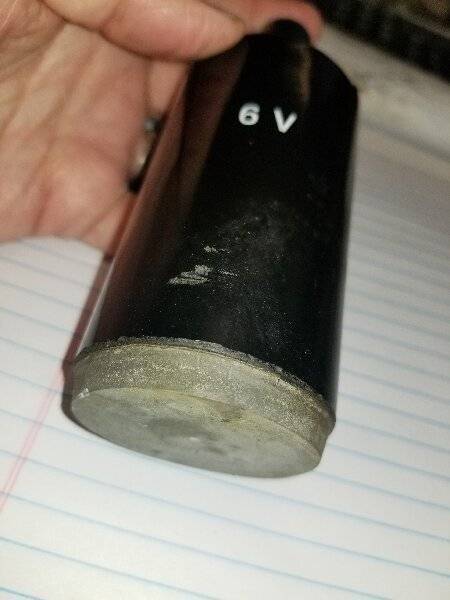|
Re: Internal or external resistor required ignition coil on a
|
||||
|---|---|---|---|---|
|
Home away from home

|
I think ballast resistors aren't necessary for a 6V system, but I might be mistaken. I have a Napa 6V coil in my 31 and it runs fine, no problems.
Assuming you have a positive ground car, the negative side of the coil (power) should connect to the ignition switch, and the positive side of the coil should connect to the distributor.
Posted on: 2022/1/3 17:08
|
|||
|
||||
|
Re: Internal or external resistor required ignition coil on a
|
||||
|---|---|---|---|---|
|
Home away from home
|
I can’t answer for a car this old but I can say that wiring it in reverse might make it have a bit less spark in the plugs than it should but I can’t imagine it making it overheat like that! I am curious to know too what happened.
Posted on: 2022/1/3 17:28
|
|||
|
All generalities are false.
Once I thought I was wrong but I was mistaken. Don Pierson Packard / IMPERIAL page CA DMV Licensed Vehicle VIN Verification 1951 Henney-Packard 3-Door Long Wheelbase Air Force Ambulance The 1951 Henney-Packard is For Sale! 1954 Packard Patrician 1954 Packard Patrician Parts Car 1956 Clipper Custom Sedan |
||||
|
||||
|
Re: Internal or external resistor required ignition coil on a
|
||||
|---|---|---|---|---|
|
Forum Ambassador
|
For what it is worth, the 29 drawings do not show any external resistor. While the drawing does show the coil internals, it is hard to tell from the drawing if there might be a resistor inside the coil but typically 6v coils did not require or have one. On a modern universal 6v coil I would not recommend using a resistor because that might make the spark too weak to reliably jump the plug gap.
12v coils use some type resistance because most often the coils are designed to work at approx 8-9 volts so as not to overheat. Working at the constant lower voltage also allows circuitry to briefly provide a separate voltage to the coil directly from the battery to sort of counteract the voltage drop due to the heavy current required by the starter motor during cranking and provide a stronger spark. As to the ignition switch, depending on type the modern designation for terminals would be BAT, IGN and ACC. BAT would be the supply in and IGN would go to the coil only while ACC would supply everything else. For the separate from coil stock Packard switch until 54, their usual designations were AM, GA and COIL. AM corresponds to BAT, GA to ACC, and COIL to IGN. If the switch has only a single on position both IGN and ACC terminals are active but in a switch with a right and left position, ACC will be active in both while IGN is only hot in the right side or the typical run position. If there is an accessory such as a fuel pump that is only wanted to be on when the engine was running that would also be powered from the IGN terminal. Here is the wiring details from thje 1929 AEA drawing available at the PAC site.
Posted on: 2022/1/3 20:21
|
|||
|
Howard
|
||||
|
||||
|
Re: Internal or external resistor required ignition coil on a
|
||||
|---|---|---|---|---|
|
Home away from home
|
Thanks for that diagram! I think I'm gonna switch to the plainest black 6 volt coil I can find and pull the switch out this weekend for a good look. Based on that diagram she's wired correctly, so, maybe in my epic struggle to get the old coil out, I've got something loose on the back of the switch or it's grounding out across the back of the coil mount. Hopefully I didn't fry the poor thing and the fuse saved my ignition switch!
Thanks much!
Posted on: 2022/1/3 22:10
|
|||
|
||||
|
Re: Internal or external resistor required ignition coil on a
|
||||
|---|---|---|---|---|
|
Home away from home
|
As I recall, the only 6-volt coils which had a resistor were the 46-48 Fords and Mercurys (maybe Lincolns too). Ford may have used resistors on earlier or later 6-volt cars, but do not know. 12-volt coils do need a resistor, ether external or internal, to prevent overheating and damage.
Posted on: 2022/1/4 14:53
|
|||
|
We move toward
And make happen What occupies our mind... (W. Scherer) |
||||
|
||||
|
Re: Internal or external resistor required ignition coil on a
|
||||
|---|---|---|---|---|
|
Home away from home

|
Quote:
This is correct. Positive ground tends to shunt the norms sometimes. Fact, most coils don't care about voltage. Old GM cars had 2 wires in the harness before it got to the coil for low voltage run, high voltage start. Of course the Mopars we know and love had the ballast resistor but also 2 wires for 12V start, ballast run. Use that as you will, but it may have been wired backward and would really overheat the small windings rather quickly. Good luck, let us know.
Posted on: 2022/1/11 10:46
|
|||
|
||||

 20211229_142533.jpg (204.67 KB)
20211229_142533.jpg (204.67 KB)










